An Exhibition of Photographs by Ansel Adams
- At March 19, 2013
- By John
- In Ansel Adams, Exhibition, Photographer, Review
 0
0
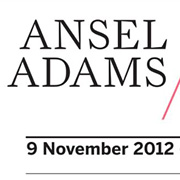
Ansel Adams: Photography from the Mountains to the Sea
“Ansel is important to us because he was a good artist; in his best days he was a terrific artist” ~ John Szarkowski, photographer & curator
If you browse any book about “icons of photography“, from photography’s inception to the current day, you’ll be hard pressed to find any mention of pure landscape photographers. It seems such a sad state of affairs that photographs of our beautiful and amazing planet are held in such low esteem by the so called photographic hierarchy. The one exception of course is Ansel Adams. However, even Ansel had to battle the establishment in his day, when from the late 19th to the early 20th century only pictorialism, the use of soft focusing, shallow depth-of-field, printing in one or more colours other than black-and-white, and on canvas or textures surfaces, was the only type of photography that was considered ‘art’ .
Photography from the Mountains to the Sea
The exhibition at the National Maritime Museum is the first Ansel Adams’s collection on view in the UK since 2008. It is said to explore water in all its forms, from turbulent views of the rapids and waterfalls to contemplative scenes of rivers and pools, in an enormity of styles and approaches. 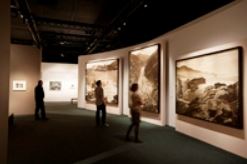 It contains around 100 photographs, all but two of them being silver gelatine prints made by the master himself, and displayed in a large hall divided into several thematic sections, with titles such as “SEA and SURF”, “COAST”, “WATERFALLS”, “CLOUDS and REFLECTIONS” etc. There is an additional viewing hall in one corner running projecting clips from several Ansel documentaries. By far the majority of the prints are 10 x 8-inch format, but many are considerably larger. Three 3 extremely large prints dominate the central foyer. These were murals were produced in the early 1950’s for the American Trust Company Building in San Francisco and each are over 6 x 9 ft in size. At the time Ansel had to pioneer new methods just to produce prints this size and they were developed in sepia for longevity and to better suite the buildings décor. Impressive in size they may be, they lack the clarity and contrast of Ansel’s other images, and although they seem to take pride of place in the exhibition, they should not, in my opinion, be viewed as examples of Ansel best print work. A copy of one I have in a book where Gravel Bars, American River, about 1950, looks stunning compared to the sepia mural exhibition version.
It contains around 100 photographs, all but two of them being silver gelatine prints made by the master himself, and displayed in a large hall divided into several thematic sections, with titles such as “SEA and SURF”, “COAST”, “WATERFALLS”, “CLOUDS and REFLECTIONS” etc. There is an additional viewing hall in one corner running projecting clips from several Ansel documentaries. By far the majority of the prints are 10 x 8-inch format, but many are considerably larger. Three 3 extremely large prints dominate the central foyer. These were murals were produced in the early 1950’s for the American Trust Company Building in San Francisco and each are over 6 x 9 ft in size. At the time Ansel had to pioneer new methods just to produce prints this size and they were developed in sepia for longevity and to better suite the buildings décor. Impressive in size they may be, they lack the clarity and contrast of Ansel’s other images, and although they seem to take pride of place in the exhibition, they should not, in my opinion, be viewed as examples of Ansel best print work. A copy of one I have in a book where Gravel Bars, American River, about 1950, looks stunning compared to the sepia mural exhibition version.
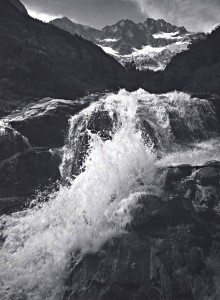
Waterfall, Northern Cascades, Washington, 1960, Ansel Adams,
Thus the exhibition presents an exciting insight on how his photography and printing developed throughout his life. Also included are some very early prints made in his teens, some of rather amateurish quality, but even in some of these you can see the first steps of his meticulous composition skills evolving even at an early age. Stars of the show will undoubtedly be Clearing Winter Storm, Yosemite National park, about 1937, and The Tetons and the Snake River, Grand Teton National Park, Wyoming, 1942. The former is a firm favourite of mine which I’ve seen printed large before, and one that my daughter has as a poster of on her bedroom wall. The latter, I’d only seen from books, so was taken aback of just how much more impressive it looked in a large print, truly awesome.
There are many fabulous images here, and although not all will enthral, there is something for everyone. There are impressive wilderness vistas, waterfalls, rivers, rocks, reflections, beaches, intimate textures and patterns and the once thing that really hits you is how fine and exacting his compositional skills are. The balance in many of these compositions is absolutely sublime
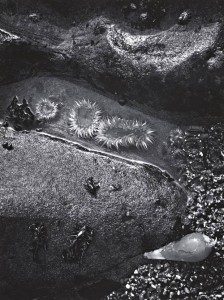
As any landscape photography will know, photographing moving water and still being able to retain the texture, form and tone without either burning out the highlights, or under exposing the surroundings is exceeding difficult. Not for Ansel Adams, as these photographs attest, as his dark room skills seem to be able eek out more texture and tone within flowing water than seemingly possible, even compared to the sophisticated tools of Photoshop today. Other areas that impressed were his water surfaces on lakes and pools which never seems to suffer from glare, and which exhibit full, deep, rich tones and glorious reflections, and where necessary depict underwater minutiae in exquisite detail without the aid of a polarizer, such as in Sea Anemones, Shore Detail, Bodega Head, California, 1969.
Grass, Water and Sun, Alaska, one of his later images dating from 1962, was another photograph that really caught my eye was, depicting such an exquisitely simple and effective composition of grass within water; an image I’d not seen before. Also impressive were Mount McKinley and Wonder lake, Denali National Park, Alaska, 1947, the large print of Sundown, the Pacific, Carmel Highlands, 1946 and Stream, Sea and clouds, Rodeo Lagoon, 1962, to mention but a few. One photograph that I’ve only ever seen in books was that of Fern Spring, Dusk Yosemite Valley, about 1962, which I’ve always thought quite ordinary, however, seeing it printed large and in full contrast, it was really impressive.
Criticism of Ansel Adams
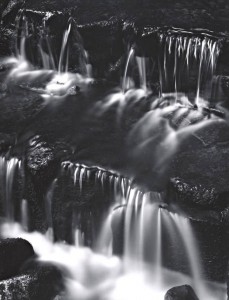
I’ve seen a few poor reviews of this Ansel Adam’s exhibition, which to me is very surprising, quite possibly as some were expecting a collection of just his greatest hits, however, this exhibition was never presented as such. One newspaper review even described Adams’s vision “at best detached, at worst cold and misanthropic” and commented that his pictures were devoid of people; and this from a ‘supposed’ quality broadsheet. These comments beggar belief, and I feel the poor chap in question either has no understanding of Ansel’s vision, simply no experience of landscape photography or perhaps just doesn’t like his pictures. Detached, maybe, but it would be a harsh comment all the same; cold, certainly not, and misanthropic, not in any way or form. It seems to me just another case of a young ‘journalist’ jumping on the current hero-bashing band wagon. Surely if you can’t moved by Clearing Winter Storm, and several others here, then I’d suspect you may well be cold, detached and devoid of any emotion yourself.
If I did have to criticise any part of this exhibition, it would perhaps be some of the rather over arty comments on some the notes that accompanying the pictures. Whilst most were informative and educational, a few were not, and one referring to a blurred waterfall was actually incorrect. But that aside the exhibition is well presented, well lit, although perhaps I’d have preferred a little more seating to plonk down and admire the photographs at length.
More than any other artist of the century, Ansel Adams would help transform the meaning of wilderness and change the way people thought and felt about their own land.
Is it Worth Visiting? – My Verdict
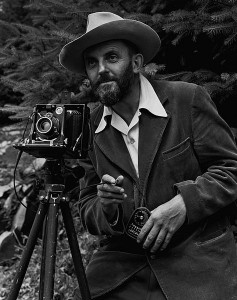 If you have any interest in landscape photography, as a photographer or as an appreciator of photographic art, then seeing any of Ansel Adams work has to be a treat if not a must. Whilst I suspect in Ansel Adams’s lifetime not all these images would be meant for public viewing, we are presented here with a chance to see how he worked, and how his photography developed from a boy through to old age. For Ansel Adams fans this exhibition is a real treat, for the casual visitor it’s a rare chance to seek of one of the most important photographers of the 20th Century. It’s thoroughly worth a visit and highly recommended.
If you have any interest in landscape photography, as a photographer or as an appreciator of photographic art, then seeing any of Ansel Adams work has to be a treat if not a must. Whilst I suspect in Ansel Adams’s lifetime not all these images would be meant for public viewing, we are presented here with a chance to see how he worked, and how his photography developed from a boy through to old age. For Ansel Adams fans this exhibition is a real treat, for the casual visitor it’s a rare chance to seek of one of the most important photographers of the 20th Century. It’s thoroughly worth a visit and highly recommended.
Ansel Adams: Photography from the Mountains to the Sea is on at the National Maritime Museum, in Greenwich, London, from the 9 November 2012 to 28 April 2013. Opening times are 10.00-17.00 (20.00 on Thursdays). For the final weekends there is late closing on Friday 19 to Sunday 21 April and Saturday 27 to Sunday 28 April, where the Ansel Adams exhibition will stay open until 19.00 (last admission 18.30). Adult ticket prices are £7 (or under) and £2 (or under) for juniors, under 5’s are free. Concessions are available.
Resources
Disclaimer
Copyright for the images used within this article are probably owned by either the original artist, the person or body who commissioned the work, or the heirs thereof. The author has used only low-resolution images of these works for illustrative and commentary purposes as stated as ‘fair use’ under United States copyright law and no infringement of any original copyright is intended or implied.

